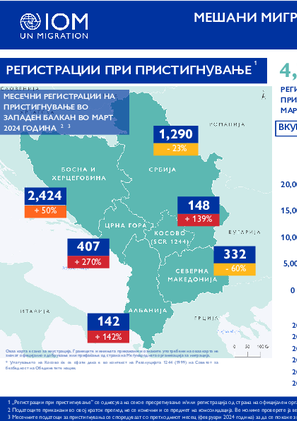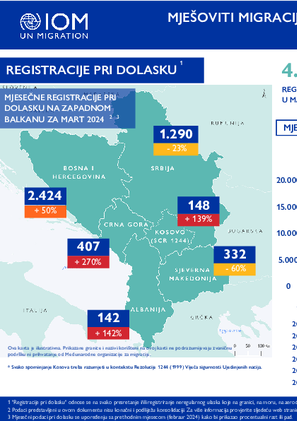-
Countries
-
Data and Analysis
-
Special Focus
-
Crisis Responses
Flow Monitoring
Domain host
migration.iom.int
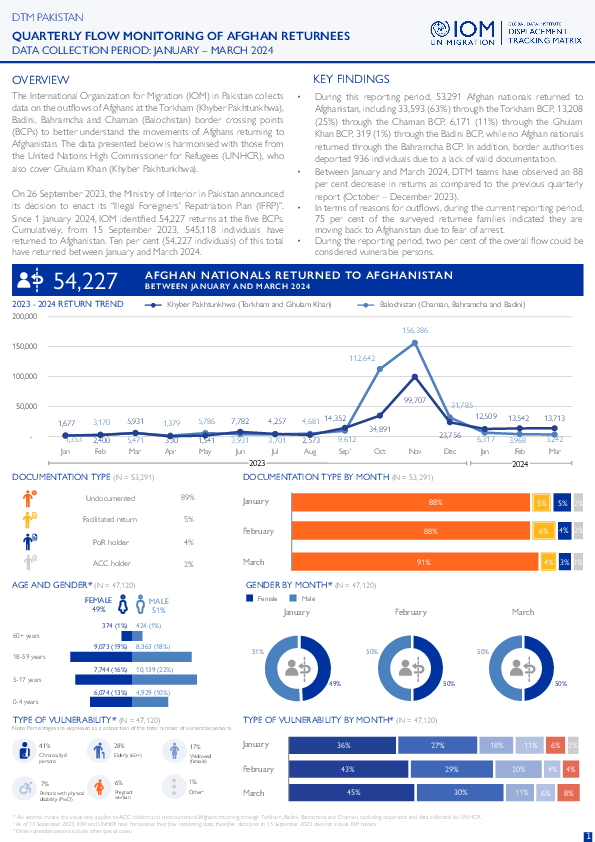
Contact
DTMPakistan@iom.int
Language
English
Location
Pakistan
Period Covered
Jan 01 2024
Mar 31 2024
Activity
- Flow Monitoring
The International Organization for Migration (IOM) in Pakistan collects data on the outflows of Afghans at the Torkham (Khyber Pakhtunkhwa), Badini, Bahramcha and Chaman (Balochistan) border crossing points (BCPs) to better understand the movements of Afghans returning to Afghanistan. The data presented below is harmonised with those from the United Nations High Commissioner for Refugees (UNHCR), who also cover Ghulam Khan (Khyber Pakhtunkhwa).
On 26 September 2023, the Ministry of Interior in Pakistan announced its decision to enact its “Illegal Foreigners’ Repatriation Plan (IFRP)”. Since 1 January 2024, IOM identified 54,227 returns at the five BCPs. Cumulatively, from 15 September 2023, 545,118 individuals have returned to Afghanistan. Ten per cent (54,227 individuals) of this total have returned between January and March 2024.
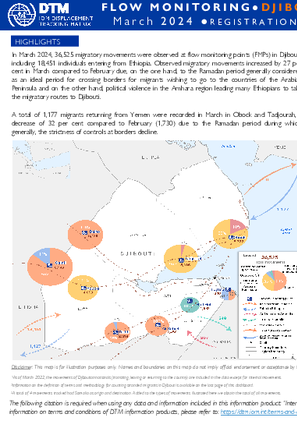
Contact
DTM Djibouti, DTMDjibouti@iom.int
Language
English
Location
Djibouti
Period Covered
Mar 01 2024
Mar 31 2024
Activity
- Flow Monitoring
In March 2024, 36,525 migratory movements were observed at flow monitoring points (FMPs) in Djibouti, including 18,451 individuals entering from Ethiopia. Observed migratory movements increased by 27 per cent in March compared to February due, on the one hand, to the Ramadan period generally considered as an ideal period for crossing borders for migrants wishing to go to the countries of the Arabian Peninsula and on the other hand, political violence in the Amhara region leading many Ethiopians to take the migratory routes to Djibouti.
A total of 1,177 migrants returning from Yemen were recorded in March in Obock and Tadjourah, a decrease of 32 per cent compared to February (1,730) due to the Ramadan period during which, generally, the strictness of controls at borders decline
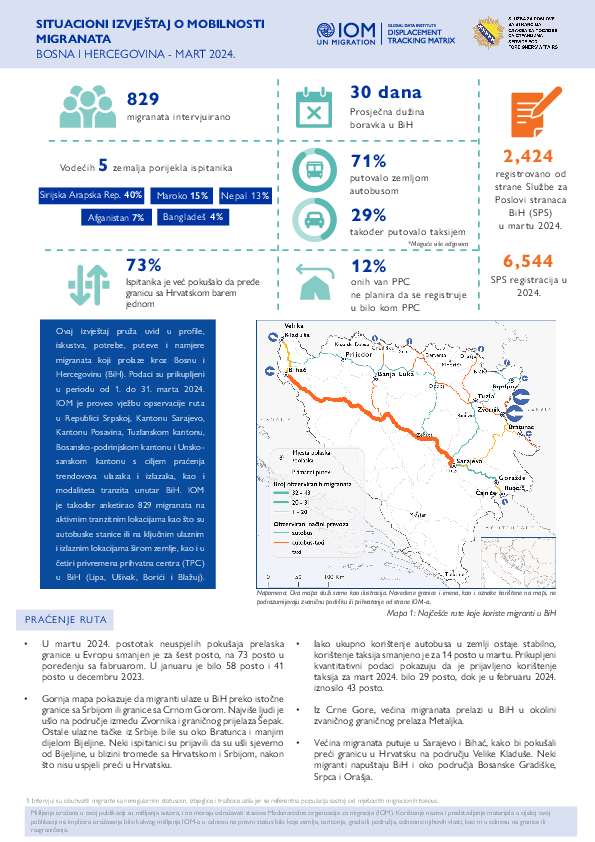
Contact
DTM Europe, DTMMediterranean@iom.int
Language
English
Location
Bosnia & Herzegovina
Period Covered
Mar 01 2024
Mar 31 2024
Activity
- Flow Monitoring
This report provides insight into the latest migration trends and patterns in Bosnia and Herzegovina (BiH). IOM surveyed 829 migrants from 1 March to 31 March 2024 in transit reception centres (TRCs) as well as in key entry, transit and exit locations around the country. The report provides insights into the profiles, experiences, needs, routes travelled and intentions of migrants transiting through BiH.

Contact
DTM Europe, DTMMediterranean@iom.int
Language
English
Location
Bosnia & Herzegovina
Period Covered
Mar 01 2023
Mar 31 2024
Activity
- Flow Monitoring
This report provides insight into the latest migration trends and patterns in Bosnia and Herzegovina (BiH). IOM surveyed 829 migrants from 1 March to 31 March 2024 in transit reception centres (TRCs) as well as in key entry, transit and exit locations around the country. The report provides insights into the profiles, experiences, needs, routes travelled and intentions of migrants transiting through BiH.

Contact
DTM Djibouti, DTMDjibouti@iom.int
Language
French
Location
Djibouti
Period Covered
Mar 01 2024
Mar 31 2024
Activity
- Flow Monitoring
En mars 2024, 36 525 mouvements migratoires ont été observés aux points de suivi des flux (FMP) à Djibouti dont 18 451 individus entrants en provenance d’Éthiopie. Les mouvements migratoires observés ont augmenté de 27 pour cent en mars par rapport à février dû, d’une part, à la période de Ramadan, généralement considérée comme une période idéale de franchissement des frontières pour les migrants désireux de se rendre vers les pays de la Péninsule Arabique, et d’autre part, des violences politiques dans la région d’Amhara, conduisant beaucoup d’Éthiopiens à emprunter les routes migratoires vers Djibouti.
Un total de 1 177 migrants de retour du Yémen a été enregistré en mars à Obock et Tadjourah soit une baisse de 32 pour cent par rapport à février (1 730) en raison de la période de Ramadan pendant laquelle, généralement, la rigueur des contrôles aux frontières baisse
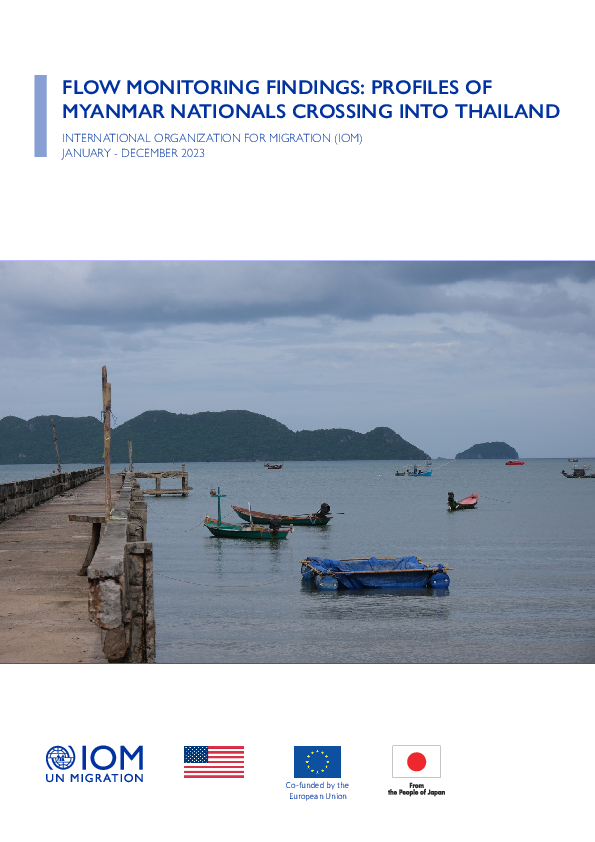
Contact
DTM Thailand, dtmthailand@iom.int
Language
English
Location
Thailand
Period Covered
Jan 01 2023
Dec 31 2023
Activity
- Survey
- Flow Monitoring
To gain a better understanding of the mobility dynamics and vulnerabilities of Myanmar nationals entering Thailand, IOM Thailand initiated flow monitoring activities at key points of entry (POEs) in Tak, Ranong, and Kanchanaburi border provinces in 2023 using IOM Displacement Tracking Matrix (DTM) tools. Flow monitoring aims track the scale and characteristics of Myanmar nationals’ mobility along the Myanmar-Thailand border, including the volume of movements and intended destinations of migrants, their reasons for movement, intended lengths of stay, and expectations about work sectors and conditions. The tool provides critical insights into current mobility dynamics in the context of the socio-economic and security situation in Myanmar following the military takeover in February 2021. The following report extends findings from the mid-year flow monitoring report published in September 2023. It covers the entire year of 2023 in Tak and Ranong, and additionally includes analysis of Kanchanaburi province from September to December 2023.
Flow Monitoring Counting (FMC) and Flow Monitoring Surveys (FMS) are conducted simultaneously at each point for one week every month. Tak, Kanchanaburi, and Ranong were chosen due to pre-existing information indicating that the three provinces experience a substantial volume of entries of Myanmar nationals.
From January to December 2023, IOM’s Migration Data and Research Unit (MDRU) interviewed a total of 4,693 incoming Myanmar nationals to Thailand, with 2,366 interviewed in Tak province (50%), 2,310 in Ranong province (49%), and 17 in Kanchanaburi province (1%).
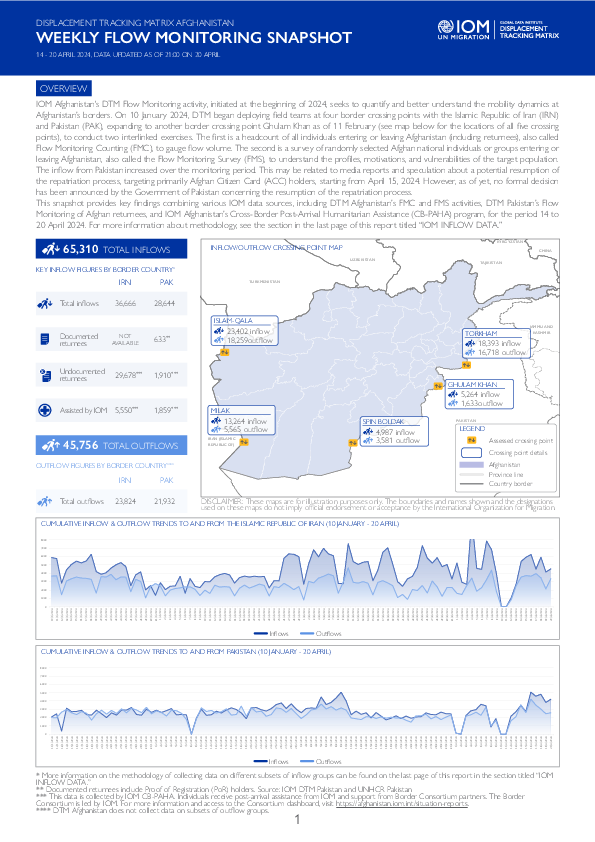
Contact
DTMAfghanistan@iom.int
Language
English
Location
Afghanistan
Period Covered
Apr 14 2024
Apr 20 2024
Activity
- Survey
- Flow Monitoring Survey
- Flow Monitoring
IOM Afghanistan's DTM Flow Monitoring activity, initiated at the beginning of 2024, seeks to quantify and better understand the mobility dynamics at Afghanistan’s borders. On 10 January 2024, DTM began deploying field teams at four border crossing points with the Islamic Republic of Iran (IRN) and Pakistan (PAK), expanding to another border crossing point Ghulam Khan as of 11 February (see map below for the locations of all five crossing points), to conduct two interlinked exercises. The first is a headcount of all individuals entering or leaving Afghanistan (including returnees), also called Flow Monitoring Counting (FMC), to gauge flow volume. The second is a survey of randomly selected Afghan national individuals or groups entering or leaving Afghanistan, also called the Flow Monitoring Survey (FMS), to understand the profiles, motivations, and vulnerabilities of the target population. The inflow from Pakistan increased over the monitoring period. This may be related to media reports and speculation about a potential resumption of the repatriation process, targeting primarily Afghan Citizen Card (ACC) holders, starting from April 15, 2024. However, as of yet, no formal decision has been announced by the Government of Pakistan concerning the resumption of the repatriation process.
This snapshot provides key findings combining various IOM data sources, including DTM Afghanistan’s FMC and FMS activities, DTM Pakistan’s Flow Monitoring of Afghan returnees, and IOM Afghanistan’s Cross-Border Post-Arrival Humanitarian Assistance (CB-PAHA) program, for the period 14 to 20 April 2024. For more information about methodology, see the section in the last page of this report titled “IOM INFLOW DATA.”
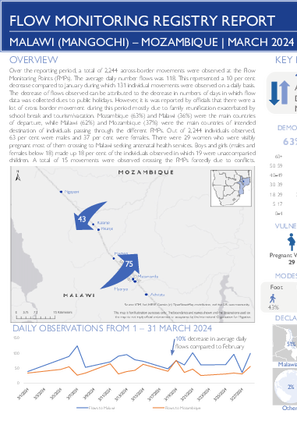
Contact
ROPretoriaRMDHub@iom.int
Language
English
Location
Malawi
Period Covered
Mar 01 2024
Mar 31 2024
Activity
- Flow Monitoring
This report is an overview of the data collected from 1 to 31 March 2024 at Mangochi FMP in Malawi along the border with Mozambique and Karonga FMP in Malawi along the border with the United Republic of Tanzania. The Flow Monitoring Registry (FMR) collects data at Flow Monitoring Points (FMPs) through direct observation and interviews with key informants, including staff working at transit stations, border patrol officers, local authorities, bus or taxi drivers and travellers themselves. The FMR gathers data on the number of travellers crossing FMPs, as well as the provenance, next destination, vulnerabilities and means of transport of travellers.
Месечен преглед на:
- Пристигнувања во Западен Балкан
- Топ три националности на лица кои пристигнале во месецот на известување
- Присуство на мигранти во прифатните објекти
- Доброволно асистирано враќање и реинтеграција
Mjesečni pregled:
- Dolasci na Zapadni Balkan
- Tri najzastupljenije nacionalnosti u izvještajnom mjesecu
- Prisustvo migranata u prihvatnim centrima
- Potpomognuti dobrovoljni povratak i reintegracija
Pagination
- Previous page
- Page 14
- Next page
